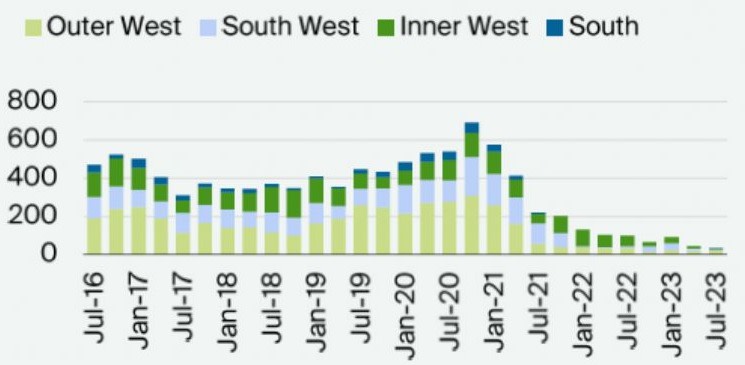Spec Builds Lift Amid Stalling Rent Growth

Australia’s vacant industrial and logistics space sits at 526,800sq m across the three eastern seaboard capital cities—36 per cent lower than the same time last year, according to global property consultants Knight Frank.
Increased speculative construction has boosted the amount of available space by 19.5 per cent in the second quarter, according to Knight Frank’s Australian Industrial Review, with upticks in Melbourne and Brisbane.
Melbourne’s vacancy increased by 37 per cent, but Sydney continued to tighten further, falling by 27 per cent in the quarter.
Knight Frank partner for research Jennelle Wilson said increases to industrial vacancy during the second quarter of this year were largely due to new speculative constructions.
“Available speculative space now accounts for 48 per cent of total east coast vacancy, with 42 per cent of this still under construction and unavailable for immediate occupation,” Wilson said.
“Leasing take-up increased by 27 per cent in the second quarter after a relatively quiet first quarter, but remains lower than the frenetic levels of 2022, with activity still impacted by the lack of opportunities available.
“The strong supply pipeline for 2023 will help to ease the tight vacancy, particularly for the east coast, with 2.6 million square metres on track to be delivered, but it won’t completely satisfy demand for modern industrial space.”
The quarterly pace of rent growth slowed in all markets except Adelaide but annual increases remain high with Sydney, Perth and Brisbane continuing to record annual growth above 20 per cent.
Knight Frank said further rental growth was expected.
Adelaide recorded the strongest rent growth over the quarter of 5 per cent, in what researchers said was the South Australian capital entering a “catch-up phase”.
Prime rent growth in key Australian cities

It was followed by Sydney at 4.4 per cent, with Australia’s most populous city recording the country’s highest annual growth of 39 per cent. That was 12 per cent ahead of the Perth, which had the second biggest growth.
Knight Frank national head of industrial logistics James Templeton said the relatively low volume of leasing deals over Q2 indicated tenants were taking a more critical look at their rents, with rising outgoings also pushing up total occupancy costs.
“However, sustained demand for new space and ongoing tight supply will continue to put upward pressure on rents, albeit at a slower pace,” he said.
“Growth is expected to revert towards an annual pace in the range of 5-8 per cent over the next 12 months.”
The critical shortage of industrial and logistics space has seen renewed investment demand in the sector over the second quarter, with $1.9 billion in transactions and more high-value transactions taking place.
The report says that although there was a similar number of recorded sales when compared with the first quarter, the turnover was $600 million-plus higher, because of those sales of more than $100 million.
The bulk of the transactions—about $1.3 billion—took place in the Sydney market.
Sydney’s industrial vacancy rate

Knight Frank found land values had stabilised, with some precincts seeing a dip in value, while yield softening continued in the quarter, albeit with greater variations between cities.
Templeton said renewed investment demand, particularly for large-scale assets and portfolios, was returning liquidity and confidence to the investment market.
“Perceived resilient tenant demand and ongoing rental growth has ensured an engaged, if discerning, buyer pool for Australian industrial assets,” he said.
“As inflation and the cost of funds landscape is appearing more settled, major investors have been quick to return to the industrial market.
“In the second half of the year the pace of activity is likely to pick up further as a more settled macroeconomic backdrop helps to narrow bid-ask spreads.”
Earlier research by Knight Frank showed the logistics sector was equal-second as the most sought-after market for investors along with the office sector, with 34 per cent of respondents saying they would target these property types over the next 18 months.
Living sectors remain the most sought-after investments.















